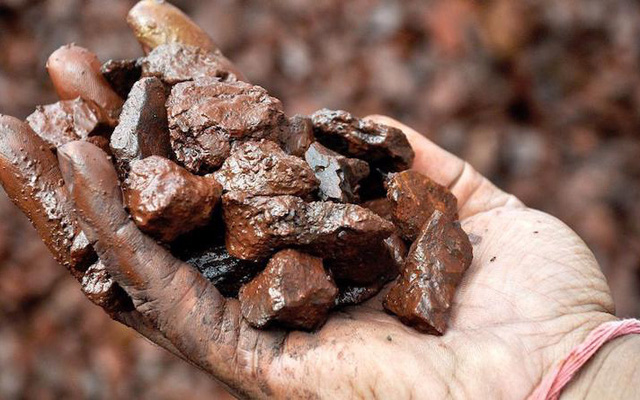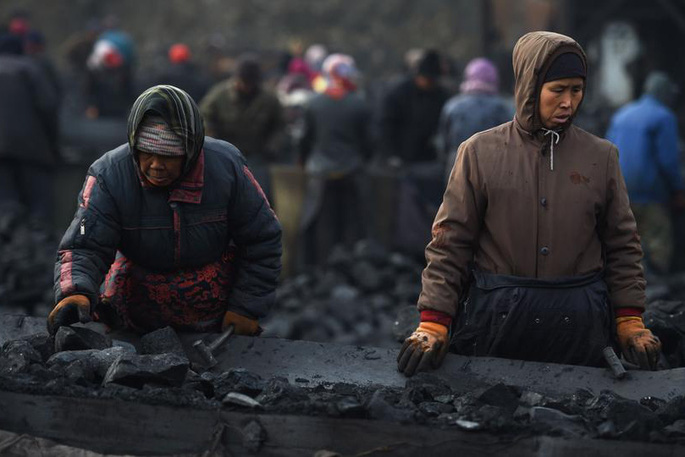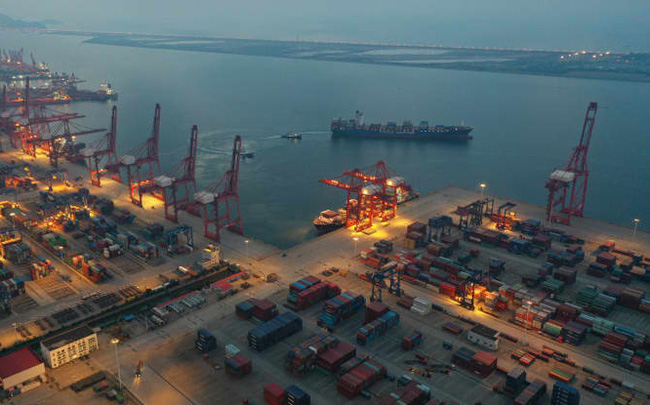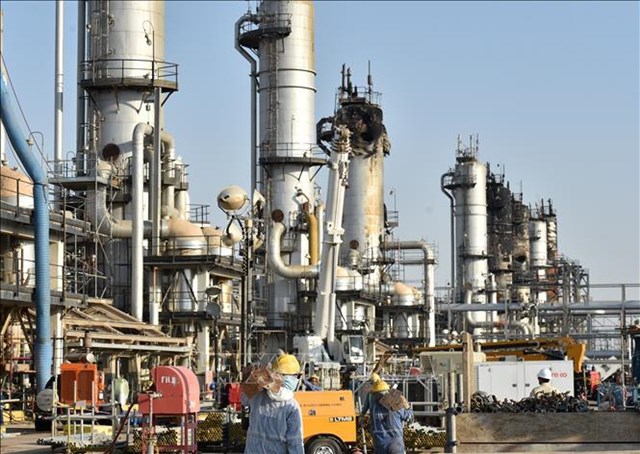Closing the session on June 22, worries about economic recession caused oil prices to drop about 3%, gold rose, copper fell to a 15-month low, iron ore hit a 16-week low, rubber fell, and wheat rose when Russia attacked in Ukrainian port.
Oil down about 3%
Oil prices fell about 3% as investors worried that an interest rate hike by the Federal Reserve could push the US economy into recession, reducing demand for fuel.
Closing session 22/6, Brent crude oil fell 2.91 USD or 2.5% to 111.74 USD/barrel, in session the price dropped to 107.03 USD/barrel, the lowest level since May 19. . WTI oil closed down 3.33 USD or 3% at 106.19 USD/barrel, the price touched 101.53 USD/barrel, the lowest since May 11 also in this session.
Investors assess how raising interest rates to cool rising inflation could hamper the economic recovery.
However, oil prices eased this session after the Fed Chairman pledged to raise interest rates to reduce inflation.
US President Joe Biden urged Congress to pass a three-month federal gas tax cut to lower prices and provide temporary relief to American families this summer. While falling gasoline prices could actually boost fuel demand and support crude prices, traders worry the Biden administration might take further steps to cool high energy prices. Lawmakers from both major parties have expressed opposition to scrapping the federal gasoline tax.
The White House asked the executives of seven oil companies to meet on June 23 to discuss ways to increase capacity and reduce gasoline prices to about $5 a gallon.
U.S. refining capacity fell for a second straight year in 2021, as plant closures continued to affect gasoline and diesel production.
The International Energy Agency (IEA) says $2.4 trillion will be invested in the energy sector globally this year, including record spending on renewables but failing to prevent a supply shortfall and solve the problem of climate change
Gold rose
Gold prices rose as lower US Treasury yields and USD boosted gold’s appeal amid growing recession fears.
Spot gold rose 0.4 percent to $1,840.39 an ounce and U.S. gold for August delivery closed at $1,838.4 an ounce.
Federal Reserve Chairman Jerome Powell said the Fed is strongly committed to reducing inflation and the pace of future rate hikes will continue to depend on upcoming data and the economic outlook. USD index fell after Powell’s speech.
Economic worries combined with soaring food prices pushed UK consumer price inflation to a 40-year high last month.
Copper falls to 15-month low
Copper fell to its lowest level in more than a year on growing fears that rapidly rising savings rates will push the global economy into recession, as China grapples with a Covid-19 lockdown. affect metal demand.
Three-month copper on the London Metal Exchange fell 2.7% to $8,757 a tonne, after falling to its lowest since March 4, 2021 at $8,656 a tonne.
The technical outlook for many LME metals is deteriorating, and a break of the $8,700 support level for copper should lead to further declines.
According to a Reuters poll, the US Federal Reserve will raise interest rates by 75 basis points in July, then by another half a percentage point in September.
The refined copper market had a surplus of 3,000 tonnes in April compared with a shortfall of 22,000 tonnes in March, according to the International Organization for Copper Research.
Dalian iron ore falls to 16-week low
Dalian iron ore prices fell to a 16-week low, while selling continued in Singapore, fueled by worries about an oversupply of steel in China, the world’s largest producer of construction and processing materials.
Iron ore for September term on the Dalian Commodity Exchange, China closed down 6% at 709.5 CNY ($105.57) per ton, continuing to decline for the 9th consecutive session. The price fell to 698.5 CNY this session, the lowest level since March 1.
The iron ore contract for July delivery in Singapore fell 5.6% to $108.45 a tonne after a day of recovery from eight sessions of declines.
In the spot market, iron ore with 62% Fe content exported to China traded at 117.5 USD/ton on June 21, according to SteelHome data, recovering from a 6-month low in Vietnam. 115.5 USD/ton achieved in the previous day.
Worries about new restrictions dampen overall domestic demand as China continues to detect new coronavirus cases day in and day out.
Disruptions in construction activity caused by the rainy season in some parts of China also led to a rise in steel inventories, prompting steel mills to shut down blast furnace operations to cut losses.
Bar in Shanghai fell 1.4%, while hot rolled coil fell 1.5%. Stainless steel fell 0.6%.
Japanese rubber prices fall according to Shanghai market
Rubber prices in Japan fell in line with weakness in the Shanghai market and low raw material prices in Thailand, the world’s top rubber producer.
However, the downside was limited as a weaker JPY made assets denominated in this currency cheaper to buy in other currencies.
The November rubber contract on the Osaka floor closed down 0.7 JPY, or 0.3%, at 254 JPY (1.86 USD)/kg.
Rubber prices in Shanghai fell mainly due to China’s Covid-19 uncertainty and lower-than-expected natural rubber demand in the country.
Rubber contract on the Shanghai Exchange for September delivery fell 175 yuan to 12,500 yuan ($1,858.71) a tonne after hitting its lowest since May 10 at 12,455 yuan.
Coffee rose
September arabica coffee futures closed up 4.05 US cents or 1.7% to 2,364 USD/lb, a two-week high.
ICE’s coffee stocks fell further to 975,821 bags, the lowest in 22 years. Dealers say coffee stocks will continue to decline at least until October, when the new crop from Honda is harvested.
In the shorter term, coffee gains are supported as financial investors begin to withdraw from stocks and virtual currencies into commodities.
A prolonged drought in June in Brazil’s coffee-growing regions also supported prices.
September robusta coffee futures rose $12 or 0.6% to $2,113 a tonne.
Falling line
Raw sugar for July delivery closed down 0.21 US cents or 1.1% at 18.45 US cents/lb.
Sugar is finding demand around 18.5 US cents, but remains largely based on negative financial market sentiment.
The shortage of sugar in the Philippines is exacerbated by lower-than-expected domestic production and by delays in the planned import of up to 200,000 tons of white sugar.
August white sugar futures fell $6.60, or 1.2%, to $553 a tonne.
Strong wheat, weak soybeans, mixed corn
U.S. wheat prices rose after falling sharply earlier in the session, as investors closed their short positions as Russia attacked a Ukrainian port.
Soybeans fell for the seventh time in eight sessions, to their lowest in more than a month as the crude market fell. Corn was mixed with old-crop contracts rising while favorable weather forecasts for early-July pollination led to a drop in new-crop contracts.
Red soft winter wheat for July delivery on the Chicago CBOT exchange closed up 3/4 US cent to 9.76-1/2 USD/bushel.
Corn for July delivery rose 7-1/4 US cents to $7.68/bushel and December corn futures fell 7-3/4 US cents to 6.03-3/4 USD/bushel.
July soybean futures fell 28-1/2 US cents to 16.52-3/4 USD/bushel, touching the lowest level since May 18.
Prices of some key items in the morning of June 23
T&G Import-Export Joint Stock Company
Address: 352 Hue Street, Le Dai Hanh Ward, Hai Ba Trung District, Hanoi
Hotline: 02473010868
Email: hrm@tginterjsc.com
Website: http://tgimportexport.com




















